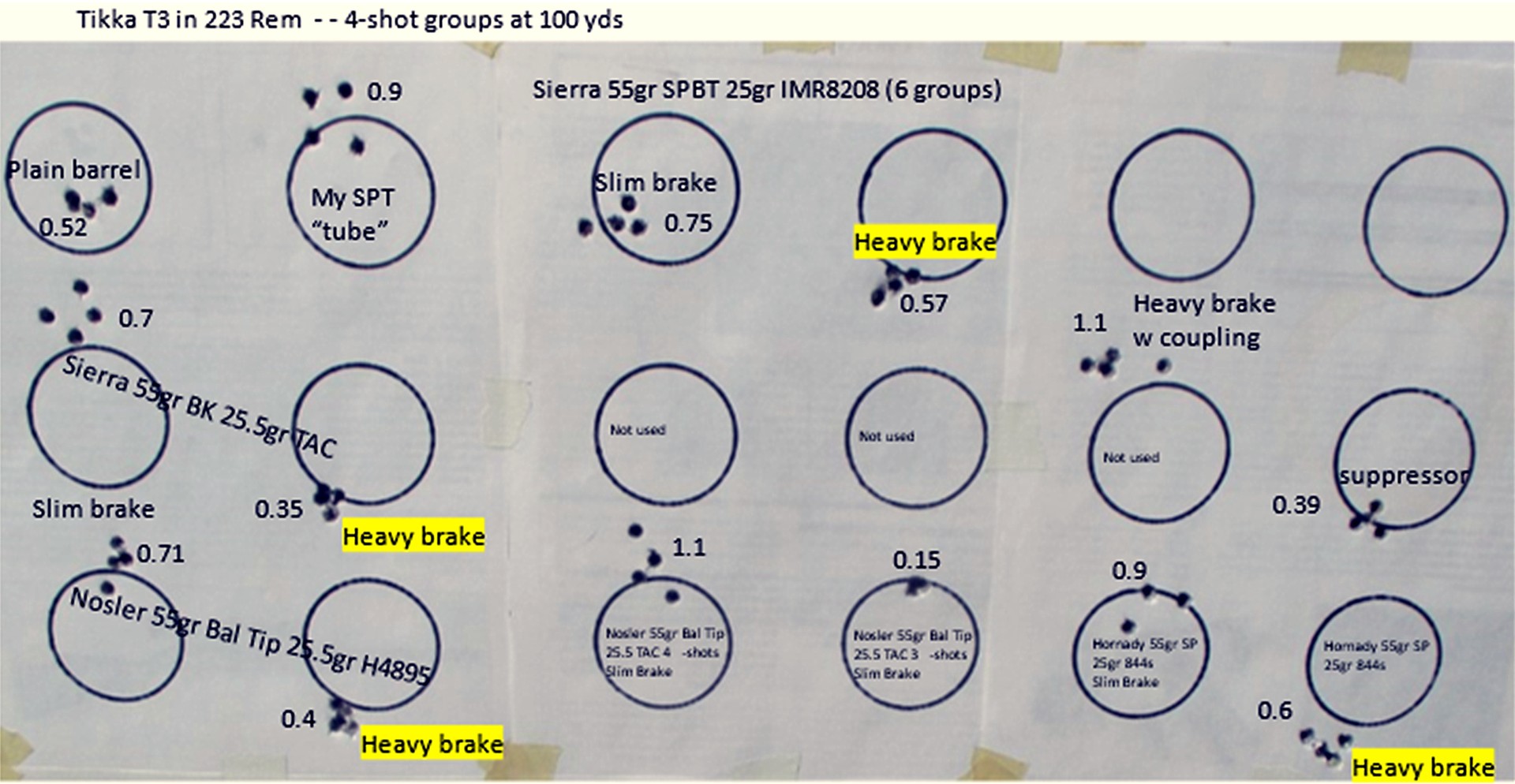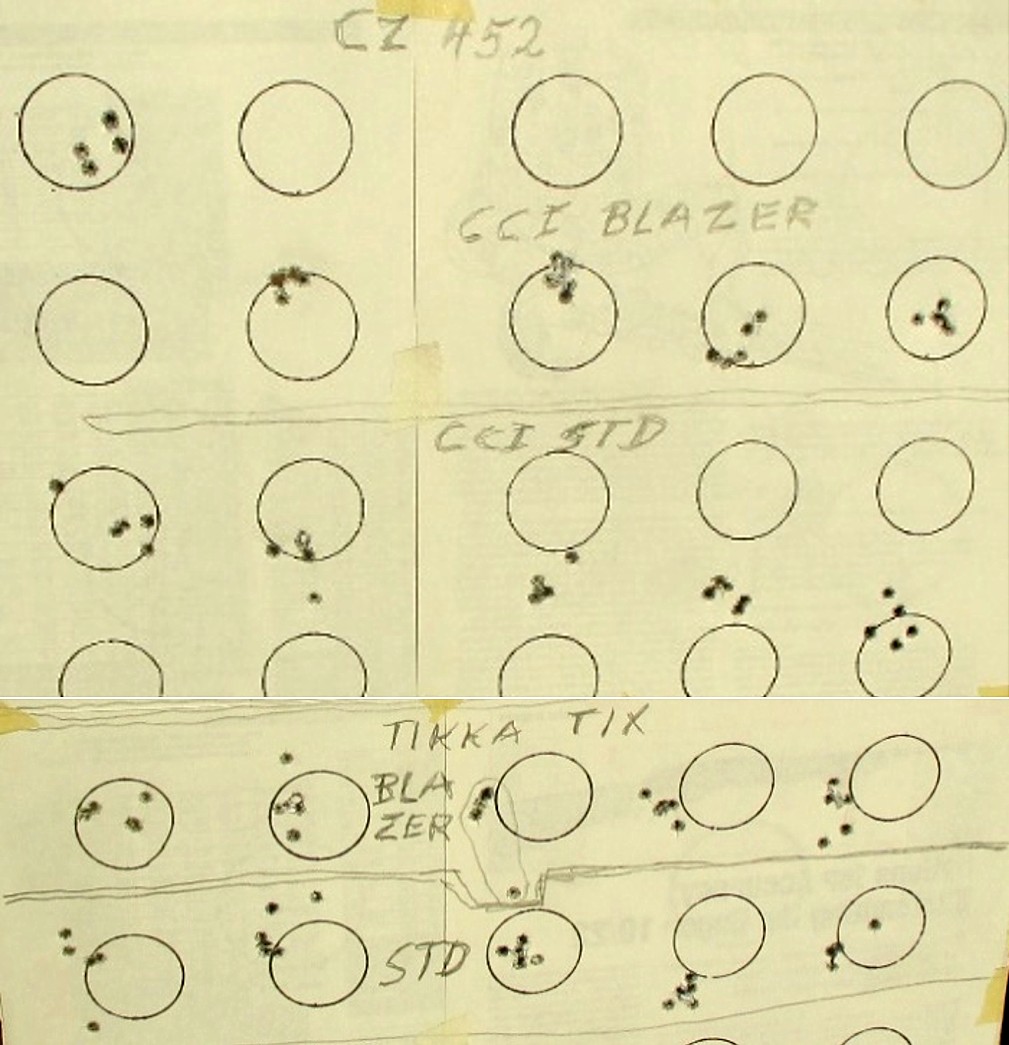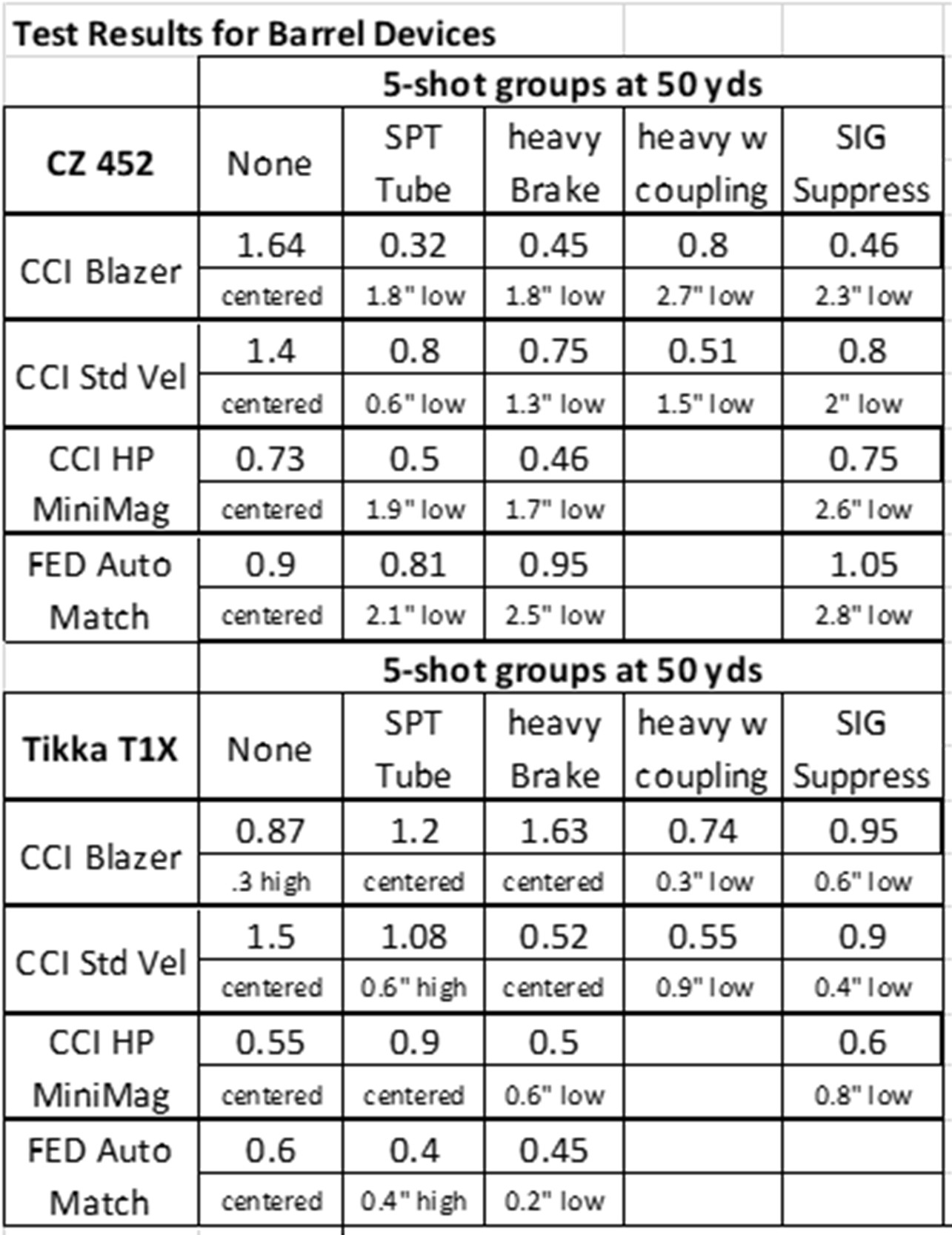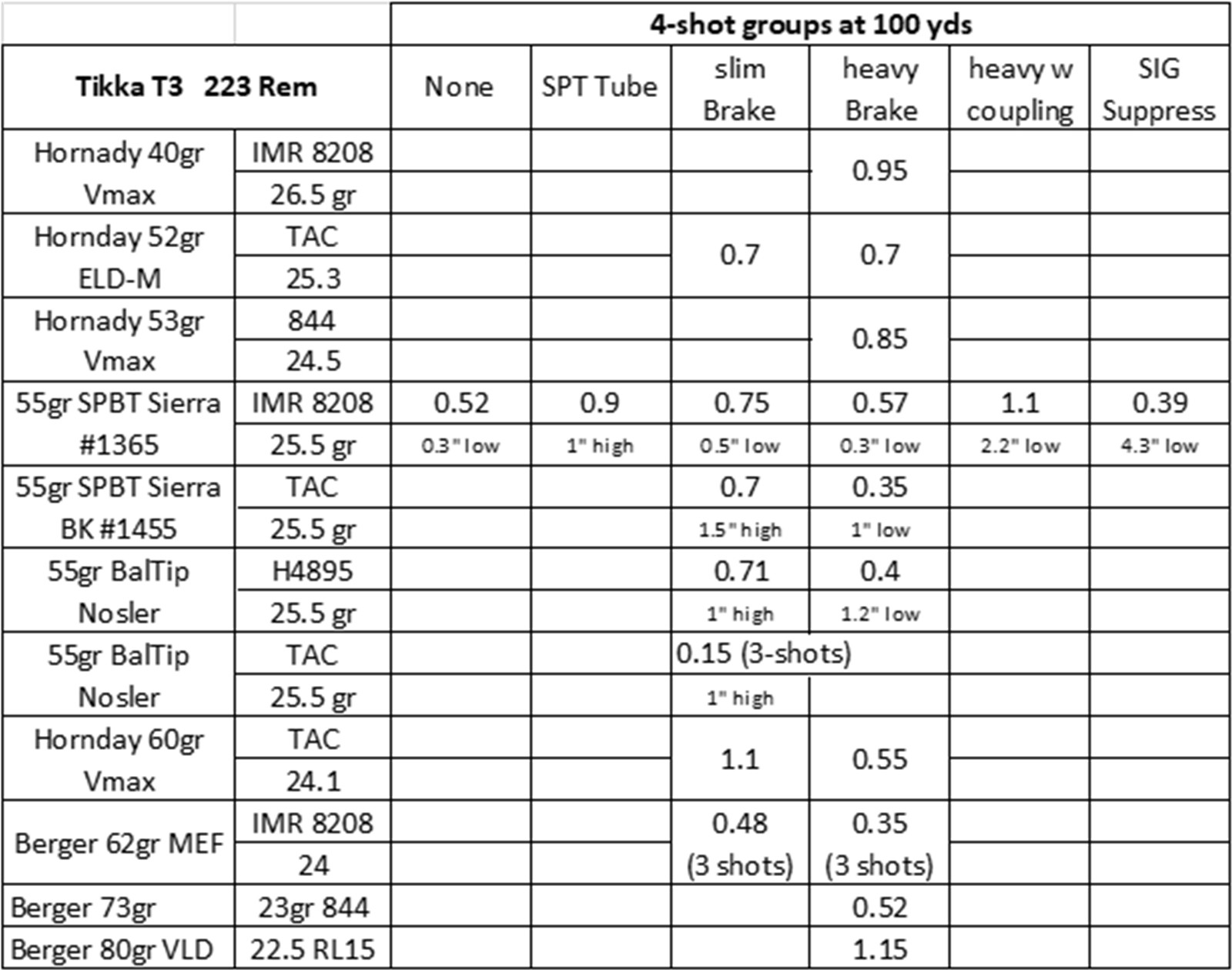
| Articles | Documents | Equipment | Events | Links | Membership | Miscellaneous | Scrapbook | Targets | What's New |
| Barrel Devices | October 2022 |
| Gerhard Schroeder | |
|
Upon thinking back quite a few years I’d say that it was basically David’s
fault. When the battle was on at the dueling trees, he seemed unbeatable
with his Buckmark, hitting those small plates fast! ‘Fast’ was the
differentiator. Apparently that long and heavy barrel on his Browning did
the trick, at least for him. That feature led me to the idea to add a pipe
to my Ruger, simulating a longer barrel. SPT – Sewer Pipe Technology
– was born, because at least in my hands those short pipes tend to make a
positive difference.
Furthermore, with the suppressor coming into my life, things changed. I did
not like that extra mass hanging off the end of my barrels, but my ears sure
did. Maybe not just my ears, also that Mauser M18. Its accuracy is out of
line with what one would expect from a thin-barreled ($500 in 2020) hunting
rifle. We all know that ammo components have been scarce. For the 6.5 PRC
especially so. Haven’t seen factory ammo for over a year, and the 150 pieces
of Hornady brass I ordered almost two years ago as of this writing have still
not been delivered. No way would I perform a test with that rifle and ammo
to learn what contribution the SigSauer suppressor makes to the M18s
outstanding accuracy. But …
These days, quite a few factory rifles already have their barrel threaded.
That of course makes it very convenient to install a brake or suppressor.
Or other schtuff. As is well known, a brake adds insignificant weight but
does a fine job of reducing recoil, at the expense of increased muzzle blast.
A suppressor adds significant weight to the rifle, reduces the muzzle blast,
typically to a level where it is no longer damaging to the human ear, and
also reduces recoil, but not as much as a brake.
So then, what happens to accuracy when such contraptions hang off the end of
a barrel? To experiment a little, I came up with one more ‘device’, involving
SPT of course, a brake with weight added. David was kind enough to do the
welding.
Here are the detailed devices, all of them with 5/8-24 threads, which became
test subjects on three rifles:
My ‘original’ SPT: two pipes and a threaded adapter beaten - I mean
interference-fitted and glued together; just a little too heavy for offhand
shooting, so I had the outer pipe turned down, which then lost the sewer pipe
appearance some. Overall length is 8.7”, with a weight of app 0.9 lbs.
“Slim” Brake: what I’ve had on my Tikka T3 in .223 Rem for several years;
Harrell Chrome Moly 3/4” OD and 2” length, weight of about 0.1 lbs.
Heavy Brake: Harrell 1” OD brake with 3/4” black pipe welded on (8” section
with threads on one end cut off) – total length of 9.6”, weighing appx. 0.9 lbs.
Suppressor: SigSauer 7.62; 1.5 lbs, 9.3” long.
Test ‘beds’ for RimFire (RF) were a CZ 452 with factory barrel modified for
5/8-24 threads and a Tikka T1X with 16.5” barrel, threaded by Tikka for 1/2-28,
onto which I installed an adapter to get 5/8-24 threads.
For CF the job went to my Tikka T3 in .223 Rem, 22.6“ factory barrel, which my
friend Ron years ago also threaded for me. All shooting was off a bench, with
target for the RF guns at 50 yds, and for CF at 100 yds. Due to the current
component situation I limited most tests to a 5-shot group for RF, and 4 shots
for CF. All data is summarized in the table below.
On my first morning of testing it became obvious that the addition of that
coupling to the ‘heavy brake’ gave inconsistent result, so I stopped testing
it. The suppressor got eliminated for the RF guns and ammo, as I would not
use that can when shooting supersonic ammo. For the .223 Rem I did test all
configurations with the first load, then shortened that test as well.
Anyway, a blank in the data means I did not test that configuration. Here
are the targets from the first morning:
Conclusions
Furthermore, for me that rifle with SPT balances better when shooting offhand.
That’s why you see that ugly rig at our matches. I don’t have much trigger
time in with the T1X, a 2021 purchase. The results here are mixed. But unlike
the CZ, this rifle is accurate with Federal Auto Match, at the time of this
writing the least expensive 22 ammo I’m aware of (Walmart – they also had CCI
STD and Mini Mag; Sportsman’s had Blazer).
In life there are countless variables. In the world of shooting we know of
many. Possibly the biggest is the nut engaging the trigger. Clearly not all
of my shots, even from a bench, were perfect. What may be a trigger-jerk-induced
flyer, or victim of wind, still got ‘counted’, meaning included in measuring the
group. Then again, occasionally variables seem to align, flirt mightily with
perfection. So it happened while testing the .223 Rem that the smallest group,
though only 3 shots, measured a memorable 0.15”. Can’t remember that I have
ever shot one that tight with a thin-barreled sporting rifle. Overall, my T3 was
very happy with the heavy brake attached. And only 3 of the groups went over an
inch in size, barely. One of those was with a VLD projectile. I’ve seen this
before in other rifles where VLDs did not produce the best accuracy, no matter
how much I changed seating depth. My experience says that Tikka knows how to
build rifles right!
Note also that the longer thinner barrels on the T3 and the 452 readily deflect
down when a weight, no matter what shape, is added to the muzzle, with groups
printing noticeably below point of aim, according to the weight of the attachment.
While not proven, the data here strongly suggests that my M18 greatly benefits
in the accuracy department when I attach that 1.5 pound suppressor to its snout.
Bottom Line – purposely attaching some weight to the end of a rifle barrel will
NOT win any sort of beauty contest, and I wonder how a short and heavy barrel
hemorrhoid may perform. Experimenting with this is relatively inexpensive.
Weight may do accuracy some good – re-zeroing required. (If your rifle muzzle
is threaded for either 1/2-28 or 5/8-24, and you want to try the SPT or heavy brake,
tell me and I’ll bring it).
© Honeywell Sportsman Club. All rights reserved. | |
|
The Honeywell Sportsman Club is a small group of shooting and outdoor enthusiasts in the Phoenix, Arizona area. Our website is ad-free and completely free to use for everyone. But we do have expenses that we need to cover, such as the web hosting fee and our liability insurance. If you enjoyed visiting our website, found it useful in some way, or if you enjoyed reading this story, please consider tipping us through our PayPal donation jar below. Thanks for visiting, and come back soon. |

|
|









